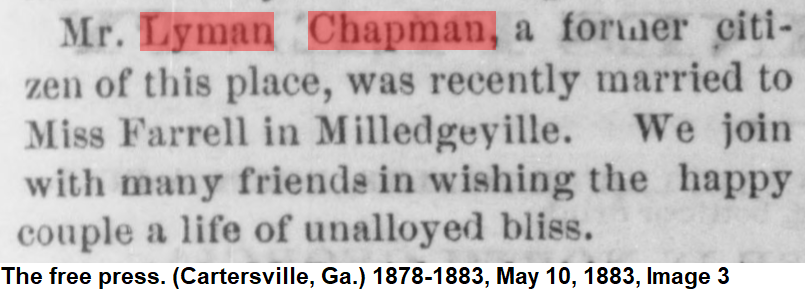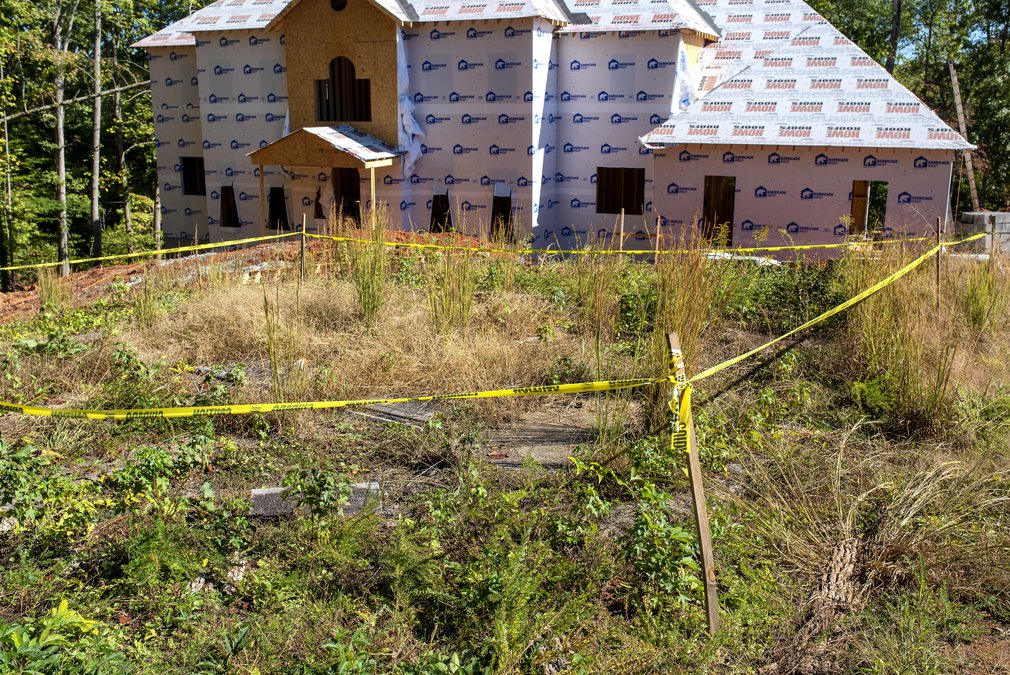The builder of the Cassville and Kingston Confederate Monuments. Lyman A Chapman.
Lyman A Chapman was born June 20th 1840. His father was Joseph Chapman and he was a brick mason in Cassville, Georgia. His mother’s name Esley Wright Chapman and they owned land in Cassville, Georgia. Joseph and Esley had 12 Children and Joseph taught each son the trade of brick masonry. Lyman Chapman Enlisted in Confederate service in 4/2/1862 at Hardeeville South Carolina in Company B of Phillips Legion also known as the Dalton guards. He was captured at Fox’s Gap, Md. On 9/14/1862, exchanged 10/2/1862; Wounded in action with a concussion May 1863 at Chancellorsville per casualty list in 5/19/1863 Atlanta Southern Confederacy; Wounded in action in the arm on 7/2/1863 at Gettysburg per casualty list in 7/20/1863 Atlanta Southern Confederacy (Rank shown as Legion Sergeant Major and shown as Sergeant Major on an Oct 1863 roll. He remained in service until 3 days before the surrender at Appomattox Virginia He was captured 3 days before the surrender at Sailors creek Virginia and was sent to New Port News. He remained in prison until June 25, 1865 and was sent home.

Lyman was a friend to many veterans and helped the Ladies Memorial Association in Cassville. After they worked hard to earn donations Lyman and the brother of Elizabeth, Walter Johnston Headden worked to build the forty foot tall Cassville monument of brick and granite with the marble plaques installed. He also build the Kingston Confederate Monument in 1876 out of cement and gravel. He also worked with the Ladies Memorial Association of Kingston. There was not a lot of fanfare for his hard work but the monuments still remain today. Chapman was very devoted to his friends who served with him. Other members of the Dalton guards remembered Lyman and he remembered every detail about them He had an interesting story about each man he served with. They thought he was a Mark Twain on a small scale with his memories of the old veterans he served with.

His first wife was Elizabeth Headden Chapman. Her father’s name was William Headden and Amanda Jane Johnston Headden. Elizabeth died during childbirth in March of 1881 leaving behind Lyman and four other children. She died at the young age of 34. Lyman happened to working in Alabama at the time and apparently was not aware Elizabeth had died. Lyman pursued a lawsuit later against the telegraph company for not contacting him. The loss of Elizabeth devoted wife must have been difficult. Lyman like his father however stayed busy with work. He built many warehouses and store fronts in Cartersville and build a colored Baptist church Mount Zion and did masonry work for the Episcopal Church in Cartersville.

Lyman’s wife Elizabeth Headden Chapman was Regina Headden’s 3x great aunt. She graduated from the Female College in Cassville in 1859 at the age of 16.
During the Civil War, Elizabeth and a few other young ladies in the town would stay with some of the widows to help the widows with chores and cooking.
In November 1864 when the town was being burned, Elizabeth helped save a lot of the family heirlooms and possessions. When the house was set on fire and the soldiers left, she put out the blaze and continued to save what she could. The soldiers returned and set fire to the house a second time. After they left, Elizabeth once again put out the fire and continued to save what she could. The soldiers returned a third time to set fire to the house. According to a story told by Warren Akin many times, the soldiers surrounded Elizabeth this time with their rifles pointed toward her. Showing no fear, Elizabeth loudly and proudly sang “The Bonnie Blue Flag” as she watched her home burn.
Elizabeth and Lyman’s son George Lyman Chapman was a medical doctor. He set up practice around Dalton for a while and moved a couple of times before settling in Dublin where his father lived. Their daughter Elizabeth Chapman married Samuel Miles Prince in Dublin, Georgia in 1897. She died at the age of 58 in 1931. A year later, Sam Miles married Elizabeth’s cousin Nancy Headden of Rome and daughter of Dr. R.B. Headden. Sam died in 1933. Lyman and his second wife Martha had two children of their own. Martha was 21 years younger than Lyman and only 9 years older than Lyman’s and Elizabeth’s oldest son William Joseph Chapman.

Lyman was called to deal with a fire in Forsyth Georgia and he turned around and offered the brick for sale. His work took him throughout Georgia and when he returned to Cartersville he was always welcome. It was in May of 1883, in Milledgeville, Georgia were he married Miss Martha Farrell Chapman. Lyman later moved to Dublin Georgia in Laurens County continuing his brick work contributing to the many building there. Later in life he applied for a Confederate Pension and later after his passing his wife also applied. Lyman died on January 11 1915 at the age of 74 and is buried at Northview Cemetery in Dublin Laurens County Georgia. His wife Martha Farrell Chapman dies on January 10, 1931 at the age of 69 buried in the same cemetery. Lyman left behind a lot of history


References
Cassville Standard February 10, 1859
North Georgia citizen. (Dalton, Ga.) 1868-1924, December 24, 1903, Image 6
The Cartersville Express June 22, 1867 Image 3
The Cartersville Express August 05 1869 Image 4
The Cartersville Express Tri Weekly August 04 1870 Image 4
The Free Press November 20, 1879
The Cartersville Express March 10, 1881 Image 3
The Free Press June 23, 1881
The Free Press May 10, 1883
Regina Headden




























